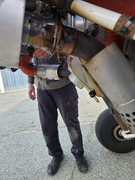Andy,
I’m not sure the service life you are experiencing is that much out of line. 500 hours does seem a bit short, but I’ve never made 1,000 hours without repairing flame tubes. Your analysis of the exhaust systems we run makes sense, not much we can do about that.
Best life I’ve gotten out of mufflers were from Dawley Aviation, top notch work. I wonder if Atlee Dodge and Dawley would tell what metal they use in their builds and what would be best for service life?
I can’t help you with LOP since the carbureted O540-J1A5D I’ve been running has too wide an EGT spread. My recollection of Lycoming’s SL is that they don’t recommend running at peak EGT until 70% or less, I ran my engine at peak EGT for over 1,000 hours but more in the 65% or less range since I cruise at 8-9,000’. Don’t know how high you cruise, but higher might be better.
A great series of articles on engine management was written by John Deakin in his column Pelican’s Perch. They are archived on AvWeb.com. You might get some ideas from a few of them I will reference here.
https://www.avweb.com/features/avweb-cl ... ne-part-1/
Pelican’s Perch #63 discusses idle mixture and setting full redline fuel flow. Could the problem be in takeoff and climb rather than cruise due to an excessively lean setting?
https://www.avweb.com/features/avweb-cl ... the-climb/
Pelican’s Perch #64 discusses takeoff EGT and a discussion of LOP in climb that makes a lot of sense to me.
https://www.avweb.com/features/avweb-cl ... -3-cruise/
Pelican’s Perch #65 discusses LOP in depth.
The J1A5D I have been running has the same rpm limits as the W1A5D you have. I mostly cruised at 2,000 rpm vs the 2,200 you have been using. Take a look at the “Motored Friction VS RPM chart which rather advocates lower rpm cruise. I’m speculating that lower rpm may help muffler life since you are pumping a lower volume of hot gasses through the exhaust.
Check out the “Outside the Box” paragraph for explanation of his (and George Braly’s) reasoning for their mixture use theories.
I think you are on the right track considering LOP. It’s hard to sort out anecdotal information from factual information. The articles I mentioned seem well thought out and logical so I choose to follow much of the advice they contain. Hope you find some useful nuggets in there.






